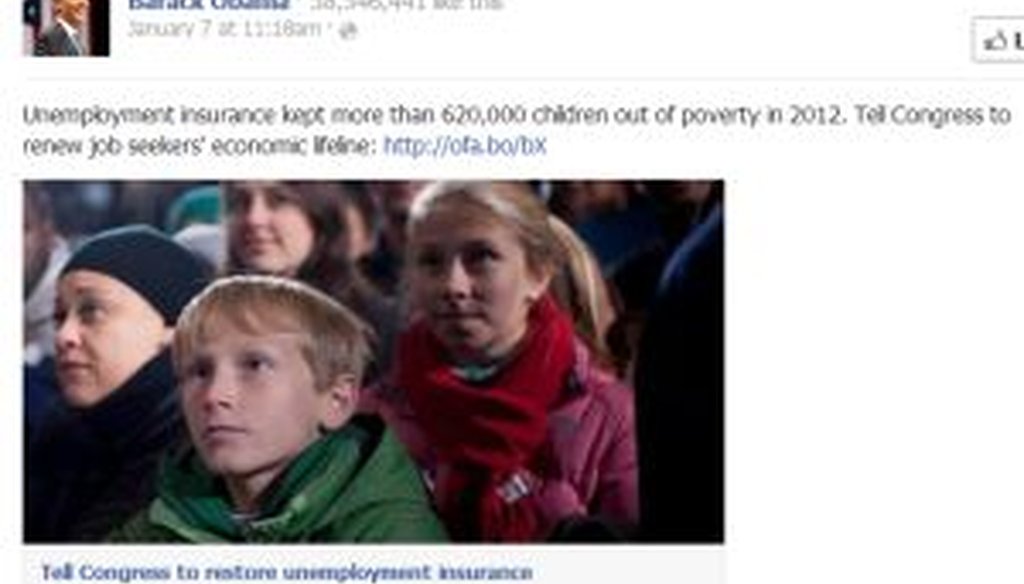

Our only agenda is to publish the truth so you can be an informed participant in democracy.
We need your help.


Barack Obama's Facebook page recently included a post about unemployment insurance. We took a closer look.
In the midst of a battle over whether to extend unemployment insurance for the long-term unemployed, President Barack Obama’s Facebook page posted this: "Unemployment insurance kept more than 620,000 children out of poverty in 2012. Tell Congress to renew job seekers' economic lifeline."
We wondered whether this claim, which was posted Jan. 7, 2014, was accurate.
We checked with Organizing for Action, the pro-Obama group that the president has deputized to handle his personal Twitter and Facebook accounts. Organizing for Action spokeswoman Katie Hogan said the numbers were based on a report by the Joint Economic Committee, a panel in Congress that consists of both House members and Senators. While the Joint Economic Committee is bipartisan as well as bicameral, the report was written by the panel’s Democratic staff, which is overseen by Sen. Amy Klobuchar, D-Minn.
In its summary table, the Joint Economic Committee report says that, nationally, 2,458,295 Americans were lifted out of poverty due to unemployment insurance payments, including 618,788 children.
According to the table, the calculations were based on U.S. Census Bureau data. Specifically, the committee used publicly available data files that had information on 387,876 individuals, with the identifying information removed. If the difference between a person’s income and the poverty line was less than the amount of unemployment insurance they had received, they were counted as having been lifted out of poverty due to unemployment insurance. This number was used as the basis for estimating the number nationally.
So, unless the Joint Economic Committee staff muffed the calculations, the Obama Facebook post was in the ballpark, though the figure was actually slightly less than 620,000, instead of "more than 620,000," as the Facebook post said.
That said, it’s worth taking a closer look at the numbers -- specifically the threshold for what counted as being in poverty.
The table notes that the committee used the Supplemental Poverty Measure rather than the traditional way of measuring poverty.
What’s the difference?
Currently, poverty is officially measured by establishing a set of income thresholds for families of different sizes and compositions, then comparing family incomes to those levels. Being in poverty means that you have an income below the threshold for your family type. But for years, scholars have debated whether there is a better way to measure poverty than the official statistic. One of the efforts to test an alternative measurement is called the Supplemental Poverty Measure.
The Supplemental Poverty Measure doesn’t just consider cash earned but also in-kind transfers such as food stamps, as well as taxes paid and medical and work-related expenses, such as child care and commuting costs, wrote University of Massachusetts-Amherst economist Nancy Folbre in a New York Times blog post. It also employs a "new standard of need, linked to what low-income families actually spend," she wrote.
In 2010, a federal interagency working group gave a green light to begin calculating the statistic, but only as long as the long-standing poverty calculation retained its official status.
Because the two poverty rates are calculated differently, the findings about how extensive poverty is in the United States are almost guaranteed to be different, though the poverty rate may end up higher for some subgroups using the supplemental method even as it is lower for other subgroups.
So how does the use of the supplemental figure shape the Joint Economic Committee’s findings? A footnote to the chart reports that while the supplemental measure found that nearly 2.5 million Americans were lifted out of poverty by unemployment benefits, the number would have been 1.7 million using the official poverty calculation.
The report doesn’t say how many children would have been lifted out of poverty using the traditional poverty calculation, but since the supplemental measure has sometimes shown lower poverty rates among children, it’s certainly plausible that the number also would be smaller than 618,788. If the proportion for children was the same as it was for individuals as a whole, the number of children lifted out of poverty would be 427,914.
Our ruling
Obama’s Facebook post said that "unemployment insurance kept more than 620,000 children out of poverty in 2012."
The number has some backing from an analysis of Census Bureau data published by the Democratic staff of Congress’ Joint Economic Committee.
However, this analysis used an unofficial poverty measure rather than the traditional one, and the report Obama’s team cites as support acknowledges that using the traditional poverty measure would have decreased the number of individuals lifted out of poverty by about one-third. A similar decrease among children would have meant the number of children would have been 427,914 rather than roughly 620,000. Overall, we rate the claim Half True.
Barack Obama, Facebook post, Jan. 7, 2014
Joint Economic Committee Democratic Staff, "The Economic Case for Continuing Federal Unemployment Insurance," January 2004
PolitiFact, "Tavis Smiley says 'one out of two Americans … are living either in or near poverty,'" April 23, 2012
Email interview with Katie Hogan, spokeswoman for Organizing for Action, Jan. 10, 2013
Email interview with Ian Jannetta, spokesman for the Joint Economic Committee Democratic staff, Jan. 13, 2013
In a world of wild talk and fake news, help us stand up for the facts.
